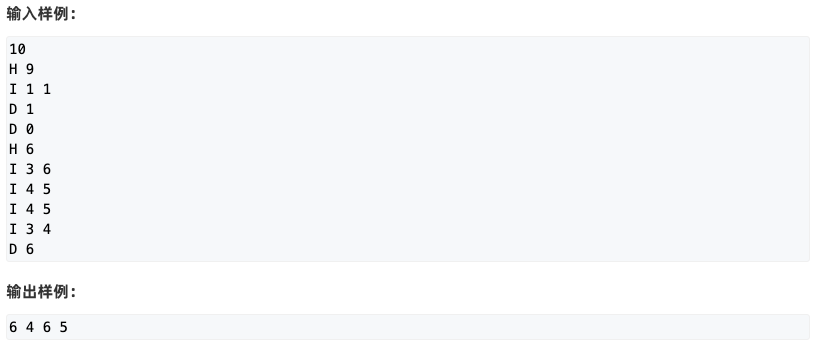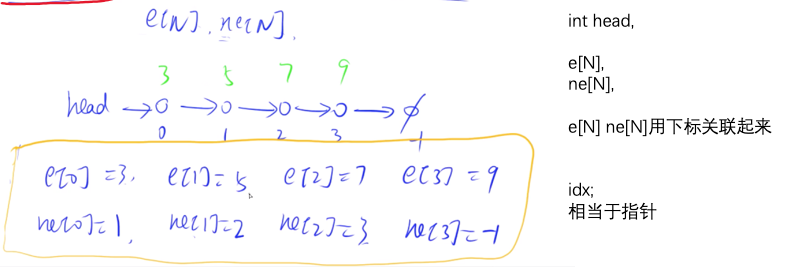单链表 邻接表
https://www.acwing.com/problem/content/828/

#include <bits/stdc++.h>using namespace std;const int N = 1e5 + 10;int m;int hh, e[N], ne[N], idx;void add_to_head(int x){e[idx] = x, ne[idx] = hh, hh = idx++;}void add_to_node(int k, int x){e[idx] = x, ne[idx] = ne[k], ne[k] = idx++;}void remove(int k){ne[k] = ne[ne[k]];}int main(){hh = -1;cin >> m;while (m--){string op;cin >> op;if (op[0] == 'H'){int x;cin >> x;add_to_head(x);}else if (op[0] == 'D'){int k;cin >> k;if (k == 0) hh = ne[hh]; //如何删除的是头结点else remove(k - 1);}else{int k, x;cin >> k >> x;add_to_node(k - 1, x);}}for (int i = hh; i != -1; i = ne[i]) printf("%d ", e[i]);puts("");return 0;}

头插法演示
单链表 结构体 TLE
// new Node(); 非常慢,链表大小1e4 1e5就会超时// 这部分代码,希望大家能看懂C语言的指针,不推荐这种写法#include <bits/stdc++.h>#include <stddef.h>// How to fix C error ‘NULL undeclared’// https://techoverflow.net/2019/06/20/how-to-fix-c-error-null-undeclared/using namespace std;const int N = 1e5 + 10;struct Node{int data, id;Node *next;};int m, idx;Node *head;void add_to_head(int x){Node *t = new Node();t->data = x;t->next = head;t->id = idx++;head = t;}void add_to_node(int k, int x){Node *t = head;while (t->next != NULL){if (t->id == k) break;t = t->next;}Node *nw = new Node();nw->data = x;nw->id = idx++;nw->next = t->next;t->next = nw;}void remove(int k){Node *t = head;while (t->next != NULL){if (t->id == k) break;t = t->next;}Node *p = t->next;t->next = p->next;delete p;}int main(){head = new Node;head->next = NULL;cin >> m;while (m--){string op;cin >> op;if (op[0] == 'H'){int x;cin >> x;add_to_head(x);}else if (op[0] == 'D'){int k;cin >> k;if (k == 0) head = head->next; //如何删除的是头结点else remove(k - 1);}else{int k, x;cin >> k >> x;add_to_node(k - 1, x);}}while (head->next != NULL){printf("%d ", head->data);head = head->next;}puts("");return 0;}
双链表 邻接表
https://www.acwing.com/problem/content/829/

#include <bits/stdc++.h>using namespace std;const int N = 1e5 + 10;int m;int e[N], L[N], R[N], idx;// k -> idx -> R[k]void insert(int k, int x){e[idx] = x;R[idx] = R[k]; // 先把idx挂好L[idx] = k;L[R[k]] = idx; // 然后弄原来的结点R[k] = idx++;}void remove(int k){L[R[k]] = L[k];R[L[k]] = R[k];}int main(){// r[0] 指向第一个点,0 1两个点作为两端,r[0] = 1, l[1] = 0 模拟成环// 用0, 1表示左端点、右端点,第一个数从idx = 2开始R[0] = 1, L[1] = 0, idx = 2;cin >> m;while (m--){string op;cin >> op;if (op == "L"){int x;cin >> x;insert(0, x);}if (op == "R"){int x;cin >> x;insert(L[1], x);}if (op == "D"){int k;cin >> k;remove(k+1);}if (op == "IL"){int k, x;cin >> k >> x;insert(L[k+1], x); // 2-index}if (op == "IR"){int k, x;cin >> k >> x;insert(k+1, x);}}for (int i = R[0]; i != 1; i = R[i]) printf("%d ", e[i]);puts("");return 0;}
循环链表 结构体
// 约瑟夫环问题// 1~n个人,从第1个人开始报数,数到m的人出列// 如此循环,直到最后一个人出列为止// 输出出列的顺序#include <bits/stdc++.h>using namespace std;struct node{int id;node *next;};node *head, *r;int n, m;int main(){cin >> n >> m;head = new node();head->id = 1;head->next = NULL;r = head;for (int i = 2; i <= n; i++){node *p = new node();p->id = i;p->next = NULL;r->next = p;r = p;}r->next = head;r = head;for (int i = 1; i <= n; i++){for (int j = 1; j <= m - 2; j++) r = r->next; //r走到了m-1的位置上cout << r->next->id << ' '; //m-1的下一个是mr->next = r->next->next; //删除结点r = r->next; //挪到下一个从1开始数}puts("");return 0;}

